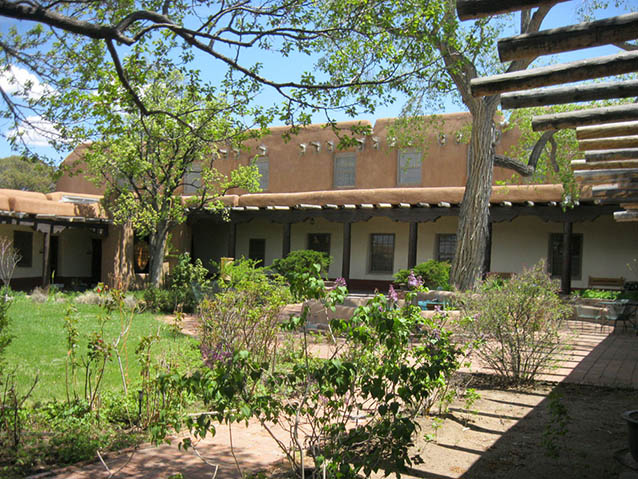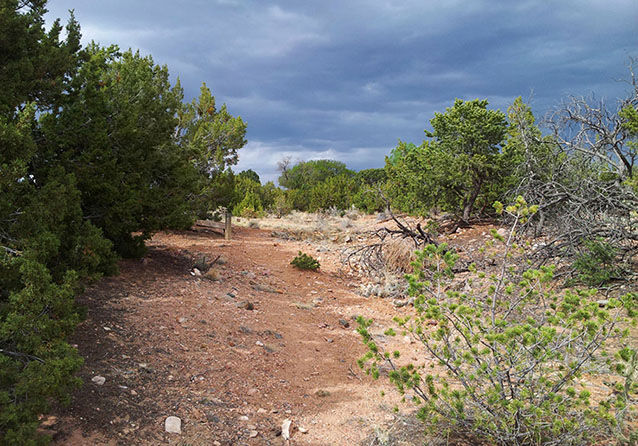The Old Santa Fe Trail Building, located in Santa Fe, New Mexico, stands at the edge of the Sangre de Cristo Mountains on about 8 acres of pinion-juniper woodland. The landscape includes the office building complex (with the building, courtyards/patios, entrance road and parking lots), Arroyo Chamiso, and surrounding pinyon-juniper vegetation.
The NPS and New Mexico State Planning Office both recognized the site as significant based on its representation of Spanish-Pueblo revival architecture, as well as association with famed architect Cecil Doty and landscape architect Harvey Cornell.

NPS / C. Mardorf
Unique elements in the landscape include lush interior and peripheral courtyards, native exterior plantings, and exterior adobe walls, which follow the edges of parking lots and signify the entrance to the site. The building and site were constructed between 1937 and 1941, during the New Deal Era. The construction period depicts the artistry and craft of the Civilian Conservation Corps (CCC) and Works Progress Administration (WPA) crews and the architectural style known as Spanish Pueblo Revival.
During the construction, the CCC crews both protected and established new stands of native vegetation near the building. In the peripheral and interior courtyards, the planting scheme utilized exotic and naturalized plants to emulate historic courtyard design.
The cultural landscape is a historic designed landscape that accurately represents the design efforts of the National Park Service, along with the work of the CCC and WPA, to construct buildings and their surrounding environments using revived and re-interpreted local vernacular design traditions. This fine attention to detail is exhibited in features such as flagstone patios, hand carved vigas inside the building as well as along the portals, adobe bancos lining the courtyards and patios, and adobe walls demarcating interior and exterior plantings and site design. The landscape retains much of its original design, which includes the walls; stone curbing; native, exotic, and naturalized vegetation; flagstone paving; and parking lots. Although the building is important for its association with the New Deal Era, the site's proximity to ruts of the Santa Fe Trail also contributes to its significance as a part of a larger historic landscape.

NPS /K. Van Fleet
In addition to its Spanish Pueblo Revival architecture, the landscape is important for its association with important designers, architects, and landscape architects, such as John Gaw Meem, Isaac Hamilton Rapp, Cecil Doty, Harvey Cornell, and others. The site has acquired additional significance for its association with the 1930s National Park Service design tenets articulated by Albert Good in Park and Recreation Structures and referred to as Parkitecture or NPS Rustic style.
Today, the Old Santa Fe Trail Building continues to house administrative offices for the National Park Service. The building is also the largest known adobe office building and one of the largest secular adobe buildings in the United States.
Quick Facts
- Cultural Landscape Type: Vernacular / Designed
- National Register Significance Level: National
- National Register Significance Criteria: A, C
- National Historic Landmark
- Period of Significance: 1937-1941
Landscape Links
Part of a series of articles titled Old Santa Fe Trail Building.
Last updated: December 28, 2020
